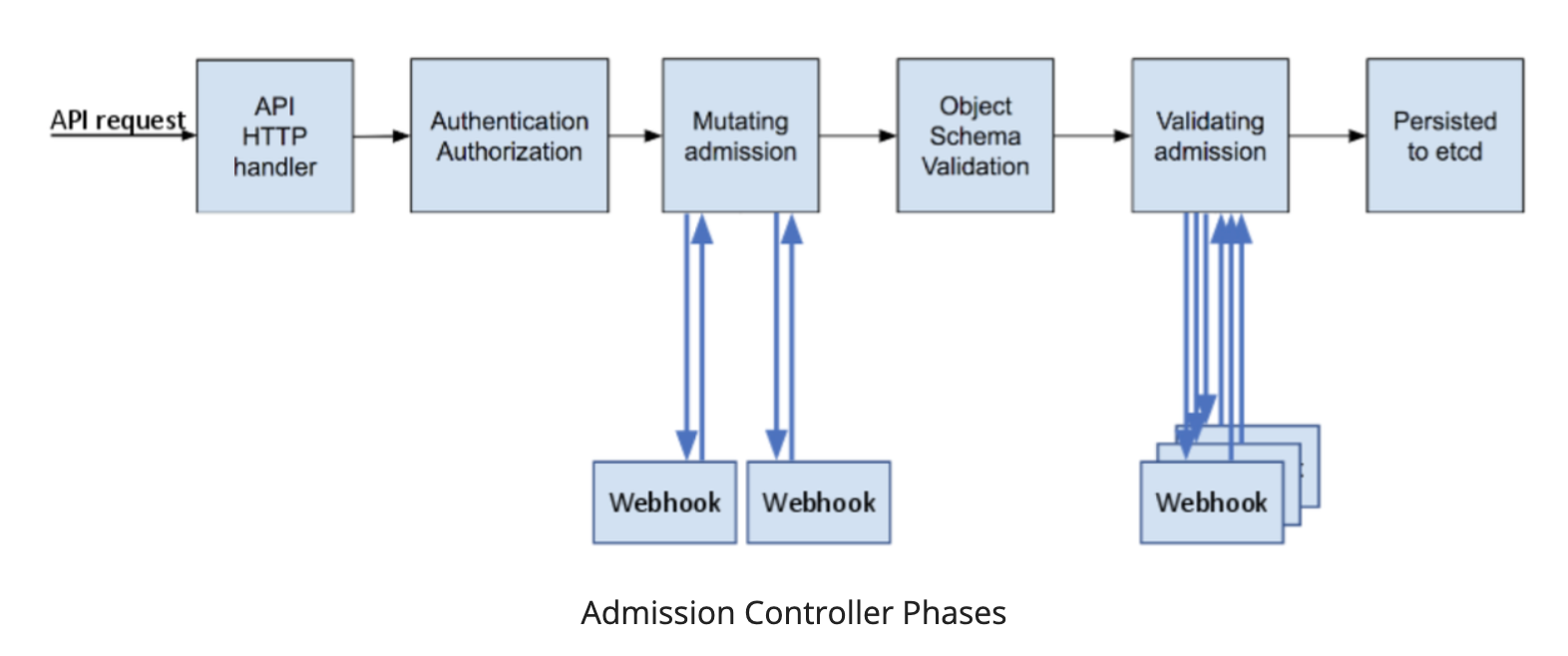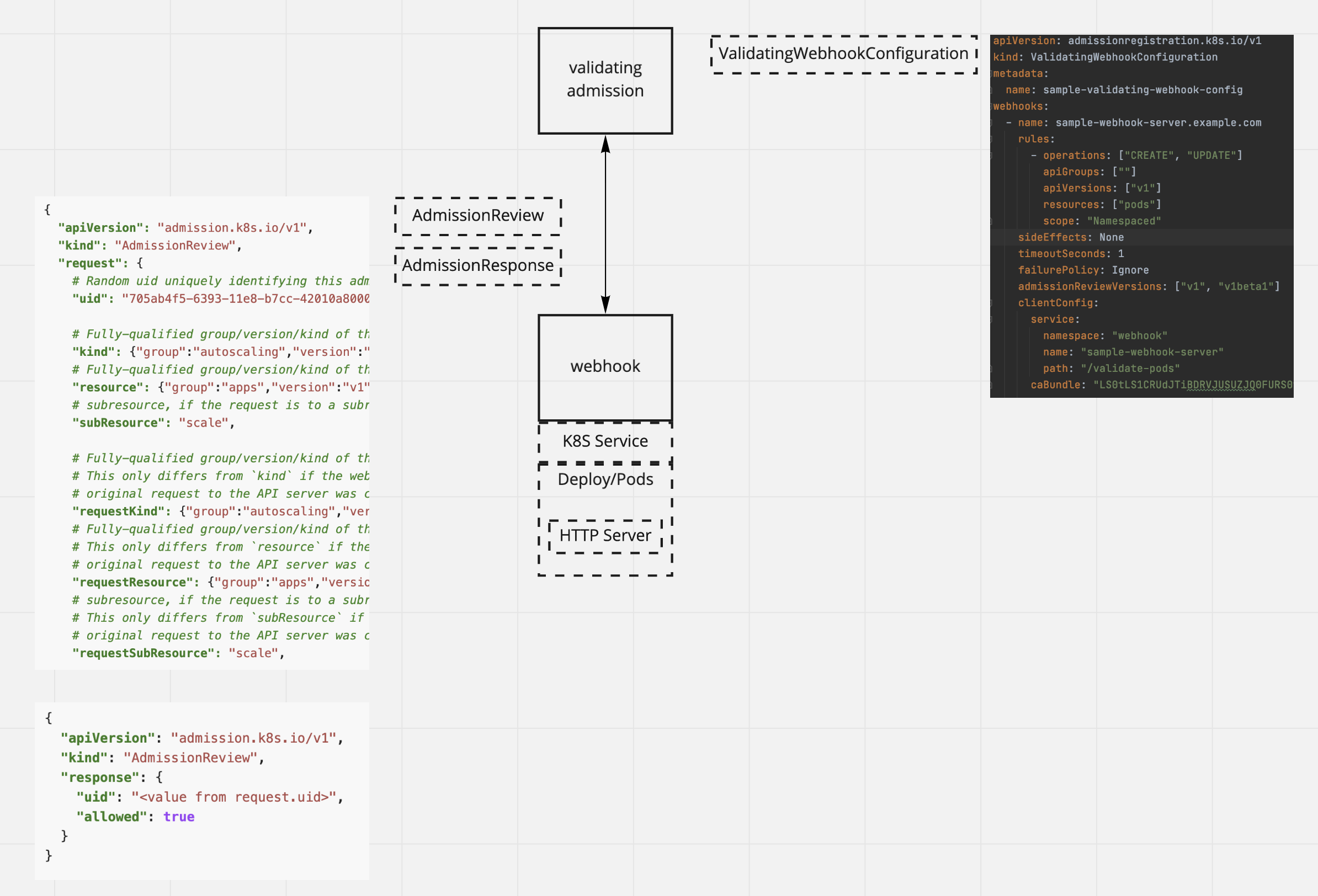Deep dive admission controllers
What are admission controllers
- Gatekeeper that intercept (authenticated) API requests and may change the request object or deny the request altogether. For example, when a namespace is deleted and subsequently enters the Terminating state, the NamespaceLifecycle admission controller is what prevents any new objects from being created in this namespace.
- Among the more than 30 admission controllers shipped with Kubernetes, two take a special role because of their nearly
limitless flexibility -
ValidatingAdmissionWebhooksandMutatingAdmissionWebhooks. This approach decouples the admission controller logic from the Kubernetes API server, thus allowing users to implement custom logic to be executed whenever resources are created, updated, or deleted in a Kubernetes cluster.

Ref: k8s-blog
How to write basic validation webhook from beginning
- https://kubernetes.io/docs/reference/access-authn-authz/extensible-admission-controllers/#admission-webhooks
- https://book.kubebuilder.io/cronjob-tutorial/webhook-implementation.html
- https://medium.com/ovni/writing-a-very-basic-kubernetes-mutating-admission-webhook-398dbbcb63ec
- https://github.com/banzaicloud/admission-webhook-example
Experiments
Missions
- Write a validating admission webhook
- If Pod has the label
webhook-validate:true. Do not allow the creation of Pod in default namespace
- If Pod has the label
- Write a mutating admission webhook
- Add some custom annotation for pods who have the label
webhook-mutate:true
- Add some custom annotation for pods who have the label
Prerequisites
-
A running K8S cluster (we will use kind in this experiment)
brew update brew upgrade kind kubectl kind create cluster --config kind.yaml --image kindest/node:v1.20.2kind: Cluster apiVersion: kind.sigs.k8s.io/v1alpha3 kubeadmConfigPatches: - | apiVersion: kubeadm.k8s.io/v1beta2 kind: ClusterConfiguration metadata: name: config apiServer: extraArgs: "enable-admission-plugins": "NamespaceLifecycle,LimitRanger,ServiceAccount,TaintNodesByCondition,Priority,DefaultTolerationSeconds,DefaultStorageClass,PersistentVolumeClaimResize,MutatingAdmissionWebhook,ValidatingAdmissionWebhook,ResourceQuota" nodes: - role: control-plane - role: worker - role: worker - role: worker -
Ensure that the admissionregistration.k8s.io/v1 or admissionregistration.k8s.io/v1beta1 API is enabled.
kubectl api-versions | grep admissionregistration admissionregistration.k8s.io/v1 admissionregistration.k8s.io/v1beta1
Write a webhook server
The code is modified based on link. It has been forked in to github.
- Checkout the code
- Build the docker image
docker build --no-cache -f Dockerfile -t sample-webhook-server:v1 --rm=true .
- Load into kind
kind load docker-image sample-webhook-server:v1
Generate certs and keys
Note: You have to change the "/CN=sample-webhook-server.webhook.svc" in genkeys.sh to be "/CN=<service-name>.<namespace>.svc"
cd $GOPATH/src/github.com/danniel1205/sample-webhook-server/
mkdir -p keys
./hacks/genkeys.sh keys
tree keys
keys
├── ca.crt
├── ca.key
├── ca.srl
├── webhook-server-tls.crt
└── webhook-server-tls.key
Create a namespace
kubectl create namespace webhook
Create secrets from the keys generated
kubectl create secret tls webhook-tls --key=./keys/webhook-server-tls.key --cert=./keys/webhook-server-tls.crt -n webhook
Create the webhook service
kubectl apply -f $GOPATH/src/github.com/danniel1205/sample-webhook-server/deploy/01-deployment.yaml
kubectl get svc,deployment,pod -n webhook
NAME TYPE CLUSTER-IP EXTERNAL-IP PORT(S) AGE
service/sample-webhook-server ClusterIP 10.99.16.47 <none> 443/TCP 2m33s
NAME READY UP-TO-DATE AVAILABLE AGE
deployment.apps/sample-webhook-server 1/1 1 1 2m33s
NAME READY STATUS RESTARTS AGE
pod/sample-webhook-server-6449948fcb-d9pq9 1/1 Running 0 25s
Create ValidatingWebhookConfiguration
Note: Update the CABundle in 02-validating-webhook-config.yaml to be base64 encoded of keys/ca.crt
kubectl apply -f $GOPATH/src/github.com/danniel1205/sample-webhook-server/deploy/02-validating-webhook-config.yaml
Try to create the test pod
kubectl apply -f $GOPATH/src/github.com/danniel1205/sample-webhook-server/deploy/test-validating-pod.yaml
Error from server: error when creating "deploy/test-pod.yaml": admission webhook "sample-webhook-server.example.com" denied the request: the namespace must be specified to create pod
Create MutatingWebhookConfiguration
Note: Update the CABundle in 03-mutating-webhook-config.yaml to be base64 encoded of keys/ca.crt
kubectl apply -f $GOPATH/src/github.com/danniel1205/sample-webhook-server/deploy/03-mutating-webhook-config.yaml
Q&A
- Why validating admission is after mutating admission ?
The reason is whatever request object a validating webhook sees needs to be the final version that would be persisted to
etcd - If we have two webhooks are applied to the same resource, in which order the request will be validated ? The request will
be validated against the webhooks specified in the
ValidatingWebhookConfiguration.webhooksone by one. Which means if the first succeeded, the request will be sent to the second one.